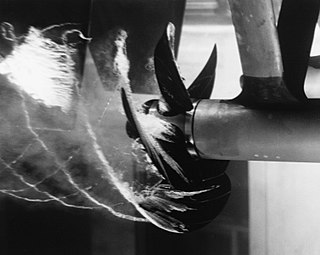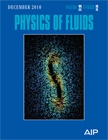
Cavitation is a phenomenon in which the static pressure of a liquid reduces to below the liquid's vapour pressure, leading to the formation of small vapor-filled cavities in the liquid. When subjected to higher pressure, these cavities, called "bubbles" or "voids", collapse and can generate shock waves that may damage machinery. These shock waves are strong when they are very close to the imploded bubble, but rapidly weaken as they propagate away from the implosion. Cavitation is a significant cause of wear in some engineering contexts. Collapsing voids that implode near to a metal surface cause cyclic stress through repeated implosion. This results in surface fatigue of the metal, causing a type of wear also called "cavitation". The most common examples of this kind of wear are to pump impellers, and bends where a sudden change in the direction of liquid occurs. Cavitation is usually divided into two classes of behavior: inertial cavitation and non-inertial cavitation.

Osborne Reynolds was an Irish-born innovator in the understanding of fluid dynamics. Separately, his studies of heat transfer between solids and fluids brought improvements in boiler and condenser design. He spent his entire career at what is now the University of Manchester.

Ernst Heinrich Weber was a German physician who is considered one of the founders of experimental psychology. He was an influential and important figure in the areas of physiology and psychology during his lifetime and beyond. His studies on sensation and touch, along with his emphasis on good experimental techniques led to new directions and areas of study for future psychologists, physiologists, and anatomists.

Ludwig Prandtl was a German fluid dynamicist, physicist and aerospace scientist. He was a pioneer in the development of rigorous systematic mathematical analyses which he used for underlying the science of aerodynamics, which have come to form the basis of the applied science of aeronautical engineering. In the 1920s, he developed the mathematical basis for the fundamental principles of subsonic aerodynamics in particular; and in general up to and including transonic velocities. His studies identified the boundary layer, thin-airfoils, and lifting-line theories. The Prandtl number was named after him.

The study of fluid mechanics, a branch of physics that studies the movement of fluids and the forces that act upon them, dates back to pre-history. The Ancient Greeks developed many of the basics of the field, while most concepts and theories used in modern physics were discovered in 17th and 18th century Europe.
Applied mechanics is the branch of science concerned with the motion of any substance that can be experienced or perceived by humans without the help of instruments. In short, when mechanics concepts surpass being theoretical and are applied and executed, general mechanics becomes applied mechanics. It is this stark difference that makes applied mechanics an essential understanding for practical everyday life. It has numerous applications in a wide variety of fields and disciplines, including but not limited to structural engineering, astronomy, oceanography, meteorology, hydraulics, mechanical engineering, aerospace engineering, nanotechnology, structural design, earthquake engineering, fluid dynamics, planetary sciences, and other life sciences. Connecting research between numerous disciplines, applied mechanics plays an important role in both science and engineering.

Flow visualization or flow visualisation in fluid dynamics is used to make the flow patterns visible, in order to get qualitative or quantitative information on them.
In dentistry, the hydrodynamic or fluid movement theory is one of three main theories developed to explain dentine hypersensitivity, which is a sharp, transient pain arising from stimuli exposure. It states that different types of stimuli act on exposed dentine, causing increased fluid flow through the dentinal tubules. In response to this movement, mechanoreceptors on the pulp nerves trigger the acute, temporary pain of dentine hypersensitivity.

Physics of Fluids is a monthly peer-reviewed scientific journal covering fluid dynamics, established by the American Institute of Physics in 1958, and is published by AIP Publishing. The journal focus is the dynamics of gases, liquids, and complex or multiphase fluids—and the journal contains original research resulting from theoretical, computational, and experimental studies.

Hubert Chanson is a professional engineer and academic in hydraulic engineering and environmental fluid mechanics. Since 1990 he has worked at the University of Queensland.

Seyed Majid Hassanizadeh is a professor of hydrogeology at Utrecht University, where he heads the Hydrogeology group at the Faculty of Geosciences. His research focuses on flow of fluids and transport of solutes and colloids in porous media, through theory development, experimental studies, and modeling work. In particular, he focuses on two-phase flow, reactive transport in variably-saturated porous media, transport of micro-organisms, and biodegradation.
The Archive of Applied Mechanics is a peer-reviewed scientific journal established in 1929 as Ingenieur-Archiv by R. Grammel. It obtained its current name in 1991 and is published by Springer. The journal covers research findings on the performance of construction materials. The editor in chief is Jörg Schröder.
(John) Trevor Stuart FRS is a mathematician and senior research investigator at Imperial College London working in theoretical fluid mechanics, hydrodynamic stability of fluid flows and nonlinear partial differential equations.

In fluid thermodynamics, Rayleigh–Bénard convection is a type of natural convection, occurring in a planar horizontal layer of fluid heated from below, in which the fluid develops a regular pattern of convection cells known as Bénard cells. Bénard–Rayleigh convection is one of the most commonly studied convection phenomena because of its analytical and experimental accessibility. The convection patterns are the most carefully examined example of self-organizing nonlinear systems.
Harvey P. Greenspan is an applied mathematician and Professor emeritus at the Massachusetts Institute of Technology. He is notable for theoretical and experimental contributions in various subjects such as wave motion, oceanography, magneto-hydrodynamics, rotating fluids, bio-fluid dynamics, mixtures, centrifugal separation and multi-phase flows.
Patrick Huerre, born in 1947, is a French physicist in fluid mechanics. An engineer from the École centrale de Paris (1970), and a doctor of aeronautical sciences from Stanford University, he began his career at the University of Southern California in Los Angeles. In 1989, he was appointed Professor of Mechanics at the École polytechnique where he created, with Jean-Marc Chomaz, and then directed the Laboratoire d'hydrodynamique (LadHyX), a joint CNRS-École polytechnique research unit. He is currently Director of Research Emeritus at the Centre national de la recherche scientifique (CNRS). He is a member of the French Academy of Sciences.

Charles Meneveau is a French-Chilean born American fluid dynamicist, known for his work on turbulence, including turbulence modeling and computational fluid dynamics.
Amit Agrawal is an Indian engineer and an institute chair professor at the department of mechanical engineering of the Indian Institute of Technology, Bombay. He leads a group of scientists who are involved in the development of next-generation diagnostic microdevices.
René Moreau is a French scientist and professor emeritus at the Institut national polytechnique de Grenoble (INPG). He is a member of the French Academy of Sciences.
Élisabeth Guazzelli is a French experimental physicist whose research concerns fluid mechanics, suspensions of particles in liquids, and particle-laden flows. She is a director of research for the French National Centre for Scientific Research (CNRS), affiliated with the Laboratoire Matière et Systèmes Complexes at the University of Paris. Currently, Guazzelli serves as the editor of the Journal of Fluid Mechanics Rapid edited by Cambridge University Press.











